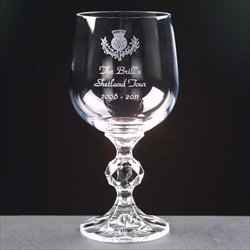Crystal Glass
|
Crystal Glass, sometimes hyphenated, as crystal-glass, is a relatively new terminology, utilised since a European ruling on what can and cannot be called Crystal. There is a large range of Crystal Glass available from The Crystal Glass Engraver Websites. Select from the Glass Engraver closest to you, or the one who specialises in the subject you are interested in – Sports Trophies, Corporate Awards etc; Crystal Glass is essentially glass – and glass is essentially made from sand. But it’s a little more than just sand, if it were, it would be very green in colour, due to the amount of iron in sand. There are a variety of oxides added to the sand, to make the glass more clear, to give it refractive colour (like a rainbow) or indeed, to make it a different colour. To make glass into crystal-glass, it needs to have 10% or more of either Lead Oxide, Zinc, Barium or Potash. Or, it can have a combination of these elements, so long as the total is equal to at least 10% of the glass mix. |
|
Rather like two chefs baking the same cake, their ingredients will differ. Flour, yes; Water, yes; but there it all ends – and the two chefs will often keep the rest of the ingredients for their recipes secret. And so it is with glassmakers – or should we call them crystal-makers? The ‘recipe’ for their ‘batch’, as it is named, will not be divulged to anyone. Some crystal glass will be heavier than other makes. Some crystal-glass will be clearer than other makes. These two factors are generally what people look for when selecting crystal glass. That is why recipes for crystal glass are so carefully guarded.
Crystal-Glass should not be confused with Lead Crystal; they are two different products. Crystal Glass is generally lighter and not as clear, so does not have the refractive colour of Lead Crystal. Nor can it be cut and then polished by use of acids. Conversely, it is arguably better than Glassware. Note that we use the term Glassware, rather than simply Glass.
You can view many ranges of crystal-glass on The Glass Engravers Websites.


